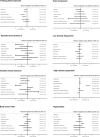Comparative effectiveness of telemedicine strategies on type 2 diabetes management: A systematic review and network meta-analysis
- PMID: 28978949
- PMCID: PMC5627243
- DOI: 10.1038/s41598-017-12987-z
Comparative effectiveness of telemedicine strategies on type 2 diabetes management: A systematic review and network meta-analysis
Abstract
The effects of telemedicine strategies on the management of diabetes is not clear. This study aimed to investigate the impact of different telemedicine strategies on glycaemic control management of type 2 diabetes patients. A search was performed in 6 databases from inception until September 2016 for randomized controlled studies that examined the use of telemedicine in adults with type 2 diabetes. Studies were independently extracted and classified according to the following telemedicine strategies: teleeducation, telemonitoring, telecase-management, telementoring and teleconsultation. Traditional and network meta-analysis were performed to estimate the relative treatment effects. A total of 107 studies involving 20,501 participants were included. Over a median of 6 months follow-up, telemedicine reduced haemoglobin A1c (HbA1c) by a mean of 0.43% (95% CI: -0.64% to -0.21%). Network meta-analysis showed that all telemedicine strategies were effective in reducing HbA1c significantly compared to usual care except for telecase-management and telementoring, with mean difference ranging from 0.37% and 0.71%. Ranking indicated that teleconsultation was the most effective telemedicine strategy, followed by telecase-management plus telemonitoring, and finally teleeducation plus telecase-management. The review indicates that most telemedicine strategies can be useful, either as an adjunct or to replace usual care, leading to clinically meaningful reduction in HbA1c.
Conflict of interest statement
The authors declare that they have no competing interests.
Figures
References
-
- International Diabetes Federation. IDF Diabetes Atlas. (International Diabetes Federation, Brussels, Belgium, 2015).
Publication types
MeSH terms
LinkOut - more resources
Full Text Sources
Other Literature Sources
Medical



